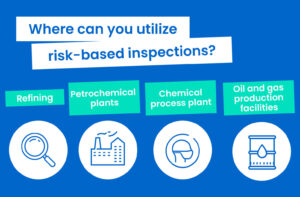Understanding the potential risks that threaten equipment integrity is essential for safe and reliable operations. Risk-Based Inspection (RBI) methods offer proven ways to proactively identify and manage these threats before they turn into critical issues. By adopting digital RBI processes, organizations can significantly enhance accuracy, reduce human error, and streamline safety assessments. Let’s explore how digitizing RBI benefits traditional industries and creates safer, more efficient workplaces.
What is a risk-based inspection?
Risk-Based Inspection (RBI) is a systematic method used to identify, evaluate, and prioritize risks associated with equipment failure. Its main goals are to:
- Identify and rank equipment based on the risk of failure, ensuring critical assets receive priority attention.
- Evaluate risks related to safety, environmental impact, and operational continuity in a cost-effective way.
- Allocate inspection resources efficiently, reducing the probability and impact of equipment failures by focusing inspections on high-risk assets.
The main objective of the RBI is to provide the groundwork for managing risks through methods, coverage, and frequency of inspections. Since this entire course of inspection works on the basis of risks, hence it could occur from the equipment, operator, or even the environment.
This is where Resco Inspections+ comes in a solution built to support teams directly on site, enabling them to document findings, capture photos, and evaluate risk levels without delay. By replacing paper forms and manual entry, it brings structure and clarity into the RBI process, helping organizations make faster and more confident decisions.
One big change to this new edition of publication is the definition of an application boundary: fixed equipment in refining, petrochemical, chemical process plants and oil and gas production facilities.
International engineering standards and practices fall under the following codes:
- API RP 580 – Risk Based Inspection
- API RP 581 – Risk Based Inspection Technology
- ASME PCC-3 – Inspection Planning Using Risk-Based Methods
- RIMAP – Risk Based Inspection and Maintenance Approach
There are two critical factors of risk analysis for RBI. First is the probability of failure (POF) assessment, through which the company evaluates the likelihood of failure due to damage, deterioration, or degradation. The second factor is a consequence of failure (COF). That represents how much it would cost if particular equipment or machinery breaks down.
Probability of Failure (POF)
In the RBI theory, risk comprises of two parts. The first of which is probability of failure (POF). It is defined as the chance that a particular asset will fail during a given time while operations are being carried out. This way POF analyzes every possible area where damage can occur and from where the entire project has the potential to be compromised. POF is calculated for individual equipment by examining the potential damage mechanisms which it may be susceptible to.
Consequence of Failure (COF)
The second part of the RBI theory is the consequence of failure (COF) which estimates failure consequences arising from faulty or damaged mechanisms or parts of a system. The purpose of the COF is to categorize assets based on the potential failure significance. These are categorized in three groups: health and safety impacts, environmental impacts, and business impacts.
The overall risk is then defined as the combination of these factors – probability and consequence.
Risk = probability of failure (POF) x consequence of failure (COF)
How does the RBI approach work?

In the first step of the RBI methodology, inspectors gather detailed information about equipment and machinery directly in the field. Using digital checklists and standardized forms, inspectors can reduce errors through real-time data validation and clear instructions. This collected data is then utilized to evaluate the Probability of Failure (POF) and Consequence of Failure (COF), establishing a strong foundation for accurate risk assessment.
There are 3 basic approaches to data collection for RBI:
- Qualitative
Takes into consideration descriptive data based on the judgment and experience of inspectors - Quantitative
Inspectors base their assessment on statistics and probability - Semi-quantitative
Organization use both approaches (qualitative and quantitative) in risk analysis
In the next step, companies proceed with the risk analysis itself, taking the probability (POF) and consequence of failure into consideration. After this assessment, companies see which inventory can pose the highest financial and safety risks. Therefore, organizations can focus on these assets and flexibly adjust their inspection and maintenance plans.
The overall goal is to mitigate the number of critical failures by optimizing maintenance activities for high-risk equipment and saving resources on low-risk assets.
What are the benefits of risk-based inspections?
To efficiently assign inspections and manage technician schedules, Field Service+ makes the process easier with an intuitive visual scheduling tool. Companies gain real-time visibility into task progress and technician status, enabling smoother operations and minimal downtime, even offline. There are several advantages to risk-based inspections over reactive approaches:
- Improving risk management by regular risk analysis assessments and its mitigation
- Minimizing downtimes by preventing critical malfunctions
- Reduced operational costs through the efficient deployment of inspection resources using digital checklists and standardized workflows provided by Inspections+
- Optimizing workforce resources by eliminating unnecessary inspections
- Usage of inspection sources in a more economical way
- Better visibility into the health of your critical assets
- Reduction in the number of failures
- Improvement in the reliability and efficiency of your equipment
- Identification and mitigation of operational risks related to equipment degradation, guided by immediate field data captured through Forms+
- Planning of maintenance activities while avoiding unnecessary shutdowns and delays
- Compliance of used equipment with the environment as well as the safety regulations
- Regular monitoring of equipment will lead to lesser technical malfunctions
Experience a personalized demo
Interested in risk-based inspections? Let us show you the real thing in a scenario tailored to your use case/business.
Where can you utilize risk-based inspections?
The definition of risk-based inspection methodology was developed and introduced by American Petroleum Institute (API). The organization published the base resource document for RBI in 2000 as API PUBL 580. It provides readers the basic guidelines for developing and implementing an RBI program.

In the API RP 581 documentation, API defines for which areas is the RBI methodology intended. It specifies quantitative procedures for fixed equipment in:
- Refining
- Petrochemical plants
- Chemical process plant
- Oil and gas production facilities
The principles focus on equipment like pressurized fixed equipment, pressure vessels, piping, tankage, pressure relief devices, and heat exchanger tube bundles.
American Petroleum Institute updated the documentation in 2008 and 2016. The most recent version – API RP 581 – contains over 1,000 technical changes compared to the previous version.
Thanks to the available resources, companies in the energy, oil and gas, or petroleum industries follow RBI principles. Outside of the American Petroleum Institute, the European Commission also published a report covering risk-based inspection and maintenance principles (RIMAP) for European companies. And UK’s Health and Safety Executive (HSE) published their recommendations and best practices for risk-based inspection as well.
What are the advantages of using risk-based inspection software?
Implementation and handling of risk-based inspections is a complex process. The organization needs to keep information about numerous assets, past inspections, repairs, and technicians’ work orders. And they have to stay connected with the workers in the field.
That’s where a software solution for risk-based inspections has the edge over the standard pen and paper process.
With the right digital tools, operations managers can receive a complete overview of critical assets’ health in one place. Besides that, inspection software can also provide insights into team performance, KPI’s, asset maintenance plans, or incidents reports. The ability to access such information from mobile or tablet improves workers’ flexibility in the field and is essential for industries like oil and gas or energy. Using Docs+, field personnel always have critical documents such as API RP 580 and API RP 581 standards readily available, ensuring compliance and reducing operational risks. It also provides version tracking, ensuring everyone stays updated with the most current information.
More advantages of risk-based inspection software include:
- Digital forms reducing the risk of failures thanks to real-time error check and instructions
- Automatic updating of maintenance plans according to identified risks
- Effective deployment of teams and individuals based on skill and location
Try Resco Inspections for your RBI
Risk-based inspections offer a way to achieve continuous optimization of work processes and eliminate downtimes. And software can play a crucial role in successful implementation of RBI best practices.
To get started with Risk-Based Inspections, discover how Inspections+ can support your business with its offline functionality, extensive customization options, and seamless integration with Field Service+ and Docs+ for a comprehensive maintenance and inspection workflow. Schedule a personalized demo to see how Resco meets your specific business needs.
